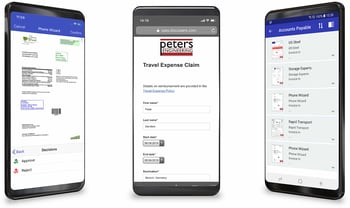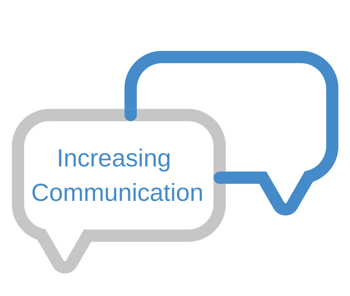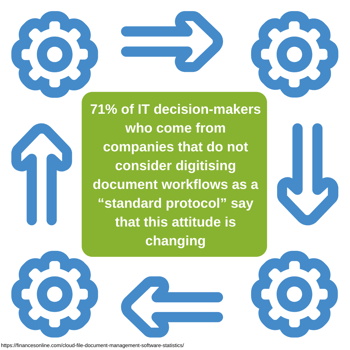Boosting user adoption of your Document Management System will bring about a variety of benefits for both staff and the business as a whole. Employees feel empowered while learning new skills, business process efficiency increases and communication between management and the rest of the team is improved.
A Document Management System reduces costs, automates repetitive manual processes and makes work life easier. But you shouldn’t take for granted that your staff will automatically be excited about the benefits of a paperless office.
User adoption becomes a challenge when employees are comfortable doing their jobs they way they’ve always done them. They can feel threatened and stressed by such a huge change to systems and processes.
With this in mind, it is key to get staff invested in the project from the very beginning. Let’s examine how our most successful projects involve their team to ensure success.
User adoption is the process of motivating software users to accept and become comfortable with new technology, or new anything! Its success starts with pinpointing the sources of resistance to change and creating strategies to break through them.
Company executives and department managers have to find ways to encourage users to try something new and build excitement about the transition by demonstrating the value it brings to them, their department and the company as a whole.
And finally, the leadership team must implement effective training to ease the switchover and ensure the software solution truly increases productivity and employee satisfaction.
User Adoption is concerned with checking that your users are embracing the new technology or processes deployed and that the project is being supported by your staff.
It is a great measure of success rate in terms of employees. The question being, are those staff using the new technology embracing the changes and conforming to the planned rollout?
Find an enthusiastic project lead in each department who will advocate for the project and share ideas and updates with their team. These people can be your ‘super users’. This person communicates their department’s needs to the project team and addresses users’ concerns.
Use their input to ensure you consider feedback from end-users who often understand more about the day-to-day work than their managers do. If you engage them in the process frequently, they start asking, “How soon can we install it?”
They see the vision and they want to see its results. For optimum user adoption, make sure project leads are available during the go-live stage to help users quickly resolve any problems. You want a user’s first experience with the solution to be very positive.
Get buy-in from your organisation’s executive team by forming a management team to sit alongside your project leaders. These execs have the power to push the paperless agenda and increase user adoption.
When top-level management communicates the objectives, it’s more likely that everyone will pay attention and develop an understanding of big-picture goals.
 Being open and transparent about future plans is key to effective change management. You share the project team’s vision for the paperless office at every opportunity. Even those who hesitate or resist moving away from familiar, paper-based processes will come around if they have been involved.
Being open and transparent about future plans is key to effective change management. You share the project team’s vision for the paperless office at every opportunity. Even those who hesitate or resist moving away from familiar, paper-based processes will come around if they have been involved.
A focus on training and talent development reassures employees that the goal is not to cut staff numbers but to involve them in more meaningful work by giving them valuable time back. Think about how your organisation can redefine roles and responsibilities so staff are motivated to embrace the change.
One good way to spread the word is by sharing videos that give a high-level view of the solution. The goal isn’t to sell users on the technology features, but to create awareness of how automating business processes takes the drudgery out of daily tasks and helps employees to achieve job-related business goals.
Designing a document workflow will include a process-mapping session that allows your team to visualise processes during the design phase. It’s a vital step in the implementation that builds understanding, transparency and ensures process optimisation. The projects where staff were involved are always more successful as they know all the process intricacies.
It’s important to make sure that a paperless solution addresses the goals of the leadership team. However, don’t minimise the importance of getting input from the end-users who will take part in each workflow.
Employees are more open to using new technology if they’ve been consulted about the design of new processes.
Depending on the system design, deploying your office automation solution may begin with the creation of a test system. Test early and often. Testing is often glossed over, but it’s a great way to avoid surprises that could cause business disruptions later. Resolve outstanding issues and demonstrate progress in regular review meetings.
This is also the time to begin training IT administrators and power users. To simulate how a process will work when the solution goes live, run through one of your processes with sample documents or files and use this as a training exercise.
Once these newly-minted experts understand the solution thoroughly, they become an in-house resource for other users. They can also take part in training the rest of the staff.
Training time can vary from a few hours for the end-users assigned to a small number of workflows to one or two days for system administrators and power users. Give end-users plenty of opportunities to practice what they’ve learned.
For example, Challs, a leading cleaning product manufacturer used the train the trainer method to really involve their team in adopting the new solutions so training was done on the job rather than theory based.
Training records and manuals are also key so that any future employees can have visibility of the training given during any stage of the rollout.
Share information about high-impact process improvements to build momentum and enthusiasm. Accounts payable, sales orders, customer service and employee management are typically good places to start.
This is another opportunity for top-level leadership to show their support and share how well the project is going. Then make plans to celebrate each success.
A Document Management System brings the many competitive advantages of office automation to your company. Employees who will use the solution should be an integral part of the digitisation effort at every step along the way, ensuring you reach the desired level of user adoption.
With DocuWare, your company can experience the advantages of state-of-the-art technology developed with the objective of offering an outstanding user experience as well.
Document control may not be the most glamorous of subjects, but if your business needs to comply with industry regulations relating to information security, sharing and storage, then read on.
The reliance on physical document storage can be a hindrance, slowing down productivity with time-consuming searches, while costing the business more than it should when expensive off-site storage facilities are required.
DocuWare integrations are something we're regularly asked about. If you're looking for a document management system it's likely integration into your organisation’s existing environment is on your list of requirements. A ...